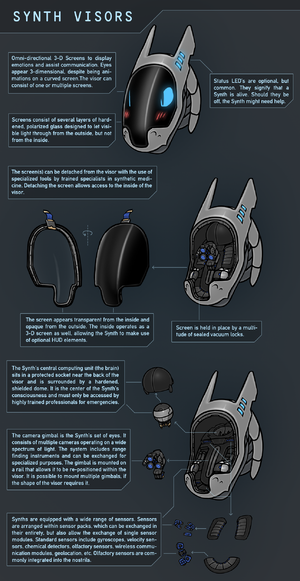Anatomy
Contents
General Features
Modularity
One of the main features of any synth is their modularity. Every synth is able to customize their body in various ways. Feet, hands, arms, legs, tails, visors, head shapes, skin style and many other internal parts can be exchanged. Module exchanges can be done for personal, professional and medical reasons. If a Synth likes the design of a pair of legs they see on display at a store and that pair of legs comes in a size that fits their current body size, the Synth can purchase it, take it home and exchange the old legs for the new ones.
Fashion
Different Synth modules in themselves are often seen as fashion items. The exterior design of most modules especially carries aesthetic significance. Every producer of parts and modules has a different visual style, with some brands being more popular among synths than others. Notable examples for brands are Virgo Synthetics, Alba Open Labs (ABL) and the Independent Outer Rim Engineering Project (IOREP), as well as a large number of smaller designer studios.
Tools
Many professions carried out by Synths require the use of tools that can be mounted directly to limbs. Some professions have size and equipment requirements that a Synth has to meet before being accepted for the position. An example would be in construction, where Synths have to be tall and strong enough to carry heavy loads, but also to fit the various power tools used during construction. Some professions require the use of precision instruments, like surgery hands with nimble fingers, scalpels, cameras and suction tools built in. The use of tool modules allows Synths to carry out very specialized tasks while they are on the job. If you can think of any specialized tool, there probably is a module that includes it.
Just like with normal tools, most specialized tool modules are owned by companies and given out to their workers as needed. Synths can also personally own tool modules that can be useful at home or in other daily situations. Cooking for organic guests is much easier when you have a cooking hand that includes knives, graters and a potato peeler. Synths who like to tinker with electronics typically own soldering and wire cutting modules.
Despite Synths having the ability to mount tool modules, they don't have to. Due to their humanoid nature, they can use most tools that organics can use as well. In most cases it is easier to simply use a normal hammer than to use an expensive module that does the same thing. Tool modules will usually only be used when it actually ends up making tasks easier than just using regular handheld tools.
Other functions
Many modules don't have a tool or fashion purpose, but still hold a benefit to the Synth or people around them. Examples are scent boxes, battery extensions and voice boxes.
Module changing process
The process of changing modules, or mounting new ones, differs wildly between different kinds of modules. Some parts are easy to exchange, such as minor cosmetic modules that are simply for show. Plating or skin tends to be easily exchangable, simply requiring the new part to be mounted and locked into place. Most Synth parts are designed in a way, that interfacting elements, such as electrical or pneumatic connections, can simply lock into place. Most sockets are standardized and designed with convenience in mind.
Some of the more complex modules however take some time for a Synth to get used to. This particularly is the case for limbs, such as legs and arms. When a Synth aquires a new limb module and mounts it for the first time, their neural networks responsible for motor functions and sensory input are not yet fully connected to the new limb. This is comparable to organics receiving limb transplants. When an organic person receives a hand transplant, it can take a long time for neural connections between the body and the new hand to build up. The hand will only be usable after these nerve connections have been established by the body. With Synths it is a similar, yet faster process. While the physical connection will be there as soon as the module is mounted in the socket, it takes the neural networks within the Synth's brain some time to catch up. This typically takes a day or two, depending on the usage of the limb. The more a Synth practices use of the new limb, the faster the neural networks can get used to it. Not being used to a new limb typically means a lack of motor skills, bad balance and not being able to properly feel the limb in question. The sensation is often described as "ants crawling on your skin". Once a Synth has gotten used to a specific limb, they can always switch back to it and will be used to it again immediately, since the Synth's neural networks remember all limbs they have ever used.
Stigma of changing parts in public
To most Synths the process of changing parts is a very personal affair. It is comparable to an organic person changing clothes. Since it often is connected with embarrassment, it typically is not done in public. Therefor it is common to find changing rooms inside stores that sell Synth modules or any other place where a Synth might have to exchange one part for another, such as work places where particular work modules are required. Synths will typically only let you see them changing parts, if they know you well enough.
Nanites
Synths are, by default, equipped with a small, internal swarm of nanites. Nanites are nano-machines, constructed by the Synth and responsible for handling much of the Synth's metabolism, as well as healing wounds, repairing internal organs and even changing the body's size and stature.
In Addition every Synth is equipped with a blueprint, a piece of software that is exchangeable and allows the Synth's body to change shape over time. Blueprints contain information as to what size and shape a synth wants to be, as well as detailed plans for the build and make-up of internal parts. Blueprints can be exchanged for different ones, depending on the Synth's personal tastes and requirements.
Once a Synth has chosen a blueprint, their internal nanites will go to work and change the Synth's body to be closer to the plans within the blueprint. Should a Synth's actual body deviate from the blueprint, the nanites will strive towards re-building the body towards the plans within the blueprint. That means they will repair damaged parts, will add or remove material from parts or even build completely new ones, should the blueprint dictate it.
The existence of a blueprint and nanites within a Synth's body therefor allows them to change their body shape, size and weight over time, as well as “heal” inflicted damage, very much like wounds healing in organics. Blueprints give nanites a plan on how a Synth's body is supposed to be and the nanites will strive towards that goal. This process still takes time, but also allows Synths to be very flexible when it comes to their stature.
Anatomy
Head
A Synth's Head is their main, most defining feature. It consists of a lightweight, shell made of layers of lightweight alloys, polymers and carbon fiber, as well as a large quantity of electronics and wiring. The internals of the head are covered by a visor, which allows the synth to see from within, as well as display emotions and other messages on the outside to assist communication. The visor itself consists of an omni-directional 3-D screen, capable of displaying 3-dimentional objects, creating the illusion that these objects exist behind the visor and within the Synth's head. This, in the vast majority of cases, is used to display eyes, to assist the synth with emotional communication and social interactions. The visor is covered by a thin plate of synthetic sapphire, making it hard and difficult to break. Visors are held in place through vacuum locks along the rim, eliminating the need for screws, bolts or glue to hold them in place. Uninstalling a visor requires soecialist tools and is usually only done at clinics or hospitals and under anaesthesia.
Many Synth head designs feature horns, antennae or other protruding features. Synthetic hair of different styles is employed as well. These features can have functional purposes, but are mostly of aesthetic use in most cases. Possible functional uses are additional wiring for improved radio wave reception, or even for improved induction charging.

